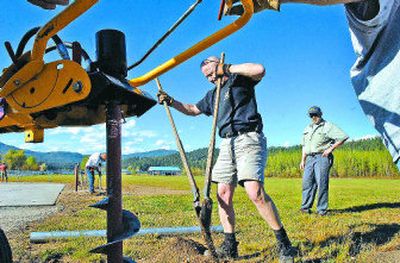To block milfoil, rinse and repeat

HAUSER – The Hauser community is launching a battle to prevent pesky plants from invading the town’s namesake lake.
The ammunition: water.
Hauser Lake is the first lake in Idaho to get a rinse station for boats to help prevent the infestation of Eurasian milfoil, which has choked thousands of acres of lakes and rivers in Idaho and Washington.
The rinse station is part of a new statewide effort to clip the advancement of milfoil, which spreads easily by clinging to boats and other watercraft.
Hauser Lake is milfoil-free, and the city wants to keep it that way.
The Hauser Lake Watershed Coalition received a $16,000 grant from the state Department of Agriculture to construct the rinse station near the only public boat launch on the lake.
On Saturday, the coalition and Kootenai County commissioners will lead a dedication of the station at Hauser Park.
“I just really hope people use it,” said Wiley Marks, a coalition member. “Our lake is clean. Keep it clean.”
Priest Lake, which is free of milfoil, also is expected to get a boat rinse station.
In less than a decade, Eurasian milfoil has invaded roughly 7,000 acres of lake and river bottoms in Idaho, forming thick mats of feathery weeds. It snuffs out native species, smothers fish and can entangle swimmers and boats.
Once waterways are infiltrated, eradication can be a costly – and sometimes controversial – venture. County governments, American Indian tribes and other entities have used herbicides and other methods to control the noxious weed.
Bonner County, for example, is planning a three-pronged strategy for Lake Pend Oreille, including dredging by divers, the use of herbicides and the introduction of a species of native weevil that reduces milfoil. Dredging involves scuba divers hand-plucking weeds – a time-consuming and tedious process.
Bonner County requested $2.4 million from the state for its eradication effort.
That’s why Hauser is working on prevention, said John Wallis, president of the Hauser Lake Watershed Coalition. “It’s really cost-effective,” he said of the rinse station.
The 625-acre Hauser Lake is popular for fishing, boating, kayaking and swimming. It is shallow – half of it is less than 20 feet deep – which makes it especially susceptible to plant growth, Wallis said.
“If Hauser gets milfoil, chances are half the lake will get milfoil,” he said. “We’re extremely concerned about it.”
Last week, volunteers put some finishing touches on the rinse station, which includes an 18-foot-by-36-foot concrete pad and two hydrants with hoses for rinsing off watercraft.
The group plans to put up a sign describing key points on equipment to check for milfoil, such as the trailer and the belly and motor of the boat. Fishing lines and equipment also should be inspected, Wallis said.
“Anything that goes in the water,” he said.
Rinsing watercraft is voluntary, but Wallis said he hopes boaters will recognize its importance.
“Once people realize it’s the fish we’re protecting, the recreational opportunities we’re protecting and the ecology of the lake we’re protecting, people will take two minutes to rinse off their boats,” Wallis said.
The Hauser Lake Watershed Coalition plans to staff the facility regularly during the summer to assist boaters and fishermen and to demonstrate to them a thorough rinsing method, Wallis said.
“People in Hauser are in love with the natural landscape,” he said. “We want to keep it as beautiful and as pristine as possible.”